Vegetation Shift of Juniperus macropoda Boisser Forest in Response to Climate Change in North-Western Himalayas, India
Abstract
:1. Introduction
2. Material and Methods
2.1. Study Area
2.2. Image Analysis
2.3. Sampling Procedure
- Otue = Position of the oldest tree in the upper elevation
- Otle = Position of oldest tree in the lower elevation
2.4. Climatic Trends of the Study Area
2.5. Statistical Analysis
3. Results and Discussion
3.1. Vegetation Change in the Lahaul Valley
3.2. Relationship between Diameter and Age
3.3. Response of Regeneration to Climate Change
3.4. Rate of Shift (m year−1)
4. Conclusions
Author Contributions
Funding
Data Availability Statement
Acknowledgments
Conflicts of Interest
References
- NOAA 2021. National Centers for Environmental Information, State of the Climate: Global Climate Report for Annual 2021. Available online: https://www.ncdc.noaa.gov/sotc/global/201713 (accessed on 28 June 2022).
- Shrestha, U.B.; Gautam, S.; Bawa, K.S. Widespread climate change in the Himalayas and associated changes in local ecosystems. PLoS ONE 2012, 7, 36741. [Google Scholar] [CrossRef] [PubMed] [Green Version]
- Xu, J.; Grumbine, R.E.; Shrestha, A.; Eriksson, M.; Yang, X.; Wang, Y.; Wilkes, A. The melting Himalayas: Cascading effects of climate change on water, biodiversity and livelihoods. Conserv. Biol. 2009, 23, 520–530. [Google Scholar] [CrossRef] [PubMed]
- Zhang, Y.; Xu, M.; Adams, J.; Wang, X. Can landsat imagery detect tree line dyanamics? Int. J. Remote Sens. 2009, 30, 1327–1340. [Google Scholar] [CrossRef]
- Dalen, L.; Hofgaard, A. Differential regional treeline dynamics in the Scandes mountains. Arct. Antarct. Alp. Res. 2005, 37, 284–296. [Google Scholar] [CrossRef]
- Grace, J.; Berninger, F.; Nagy, L. Impacts of climate change on the tree line. Ann. Bot. 2002, 90, 537–544. [Google Scholar] [CrossRef] [PubMed] [Green Version]
- Bhattarai, K.R.; Vetaas, O.R. Variation in plant species richness of different life along a subtropical elevation gradient in the Himalayas, East Nepal. Glob. Ecol. Biogeogr. 2003, 12, 327–340. [Google Scholar] [CrossRef]
- Smith, S.A.; Beaulieu, J.M. Life history influences rates of climatic niche evolution in flowering plants. Biol. Sci. 2009, 276, 4345–4352. [Google Scholar] [CrossRef] [Green Version]
- Korner, C. Alpine Plant Life: Functional Plant Ecology of High Mountain Ecosystems; Springer: Berlin, Germany, 2003. [Google Scholar]
- Currie, D.J.; Mittelbach, G.G.; Cornell, H.W.; Field, R.; Guegan, J.F.; Hawkins, B.A.; Turner, J.R.G. Predictions and tests of climate-based hypotheses of broad-scale variation in taxonomic richness. Ecol. Lett. 2004, 7, 1121–1134. [Google Scholar] [CrossRef]
- Pepin, N.C.; Lundquist, J.D. Temperature trends at high elevations: Patterns across the globe. Geophys. Res. Lett. 2008, 35, 14701. [Google Scholar] [CrossRef] [Green Version]
- Rangwala, I.; Miller, J.R. Climate change in mountains: A review of elevation-dependent warming and its possible causes. Clim. Chang. 2012, 114, 527–547. [Google Scholar] [CrossRef]
- Fes, A.S. Deriving Lapse Rates of Slope Air Temperature for Meltwater Runoff Modeling in Subtropical Mountains: An Example from the Punjab Himalaya, Pakistan. Mt. Res. Dev. 1997, 17, 353–362. [Google Scholar] [CrossRef]
- Simard, M.; Pinto, N.; Fisher, J.B.; Baccini, A. Mapping forest canopy height globally with spaceborne lidar. J. Geophys. Res. 2011, 116, 4021. [Google Scholar] [CrossRef] [Green Version]
- Wang, X.P.; Fang, J.Y.; Tang, Z.Y.; Zhu, B. Climatic control of primary forest structure and DBH-height allometry in Northeast China. For. Ecol. Manag. 2006, 234, 264–274. [Google Scholar] [CrossRef]
- Topaloglu, E.; Ay, N.; Altun, L.; Serdar, B. Effect of altitude and aspect on various wood properties of Oriental beech (Fagus orientalis Lipsky) wood. Turk. J. Agric. For. 2016, 40, 397–406. [Google Scholar] [CrossRef]
- Kumar, D.; Bhardwaj, D.R.; Sharma, P.; Sankhyan, N.; Al-Ansari, N.; Linh, N.T.T. Population Dynamics of Juniperus macropoda Bossier Forest Ecosystem in Relation to Soil Physico-Chemical Characteristics in the Cold Desert of North-Western Himalaya. Forests 2022, 13, 1624. [Google Scholar] [CrossRef]
- Kumar, D.; Bhardwaj, D.R.; Sharma, H.; Sharma, P.; Pala, N.A. Species diversity assessment along altitudinal gradient in cold desert Juniperus forest of north-western Himalaya. Indian For. 2022, 148, 459–466. [Google Scholar] [CrossRef]
- Luna, R.K. Plantation Trees; International Book Distributor: Dehradun, India, 1995; pp. 905–906. [Google Scholar]
- Korouri, S.A.A.; Khoshnevis, M.; Matinizadeh, M. Comprehensive Studies of Juniper Species in Iran; Forest Range and Watershed Management Organization: Tehran, Iran, 2012; pp. 144–193.
- Ahani, H.; Jalilvand, H.; Hosseini, N.S.M.; Soltani, K.H.; Ghazi, M.R.; Mohammadz, H. Reproduction of Juniperus polycarpus in Khorasan Razavi, Iran. For. Sci. Pract. 2013, 15, 231–237. [Google Scholar] [CrossRef]
- Xu, J.; Grumbine, R.E. Building ecosystem resilience for climate change adaptation in the Asian highlands. Wiley Interdiscip. Rev. Clim. Chang. 2014, 5, 709–718. [Google Scholar] [CrossRef]
- Bhattacharyya, A.; Lamarche, V.C.J.; Hughes, M.K. Tree ring chronologies from Nepal. Tree Ring Bull. 1992, 52, 59–66. [Google Scholar]
- Bhuju, D.R.; Carrer, M.; Gaire, N.P.; Soraruf, L.; Riondato, R.; Salerno, F.; Maharjan, S.R. Dendroecological study of high-altitude forest at Sagarmatha National Park, Nepal. In Contemporary Research in Sagarmatha (Mt. Everest) Region; Jha, P.K., Khanal, I.P., Eds.; Nepal Academy of Science and Technology: Lalitpur, Nepal, 2010; pp. 119–130. [Google Scholar]
- Cook, E.R.; Krusicm, P.J.; Jones, P.D. Dendroclimatic signals in long tree ring chronologies from the Himalayas of Nepal. Int. J. Climatol. 2003, 23, 707–732. [Google Scholar] [CrossRef]
- Gaire, N.P.; Dhakal, Y.R.; Lekhak, H.C.; Bhuju, D.R.; Shah, S.K. Dynamics of Abies spectabilis in relation to climate change at the treeline ecotone in Langtang National Park. Nepal J. Sci. Technol. 2011, 12, 220–229. [Google Scholar] [CrossRef]
- Sano, M.; Furuta, F.; Kobayashi, O.; Sweda, T. Temperature variations since the mid-18th century for Western Nepal as reconstructed from tree-ring width and density of Abies spectabilis. Dendrochronologia 2005, 23, 83–92. [Google Scholar] [CrossRef]
- Champion, H.G.; Seth, S.K. A Revised Survey of Forests Types of India; Manager Publication Delhi: Delhi, India, 1968; 72p. [Google Scholar]
- Dubey, B.; Yadav, R.R.; Singh, J.; Chaturvedi, R. Upward shift of Himalayan pine in Western Himalayan, India. Curr. Sci. 2003, 85, 1135–1136. [Google Scholar]
- Addinsoft. XLSTAT Statistical and Data Analysis Solution; Addinsoft: Long Island, NY, USA, 2020. [Google Scholar]
- SPSS Inc. SPSS Statistics for Windows; Version 17.0; SPSS Inc.: Chicago, IL, USA, 2008. [Google Scholar]
- Bakerv, B.B.; Moseley, R.K. Advancing treeline and retreating glaciers: Implications for conservation in Yunnan, P.R. China. Arct. Antarct. Alp. Res. 2007, 39, 200–209. [Google Scholar] [CrossRef] [Green Version]
- Rawat, D.S. Monitoring ecosystem boundaries in the Himalaya through an ‘eye in the sky’. Curr. Sci. 2012, 102, 1352–1354. [Google Scholar]
- Liang, E.; Wang, Y.; Eckstein, D.; Luo, T. Little change in the fir tree-line position on the southeastern Tibetan Plateau after 200 years of warming. New Phytol. 2011, 190, 760–769. [Google Scholar] [CrossRef] [PubMed]
- Lv, X.; Zhang, Q.B. Asynchronous recruitment history of Abies spectabilis along an altitudinal gradient in the Mt. Everest region. J. Plant Ecol. 2012, 5, 147–156. [Google Scholar] [CrossRef] [Green Version]
- Korner, C.; Paulsen, J. A world-wide study of high-altitude treeline temperatures. J. Biogeogr. 2004, 31, 713–732. [Google Scholar] [CrossRef]
- Pachauri, R.K.; Allen, M.R.; Barros, V.R.; Broome, J.; Cramer, W.; Christ, R.; Church, J.A.; Clarke, L.; Dahe, Q.; Dasgupta, P.; et al. Climate Change 2014: Synthesis Report. Contribution of Working Groups I, II and III to the Fifth Assessment Report of the Intergovernmental Panel on Climate Change; IPCC: Geneva, Szwitzerland, 2014; 151p. [Google Scholar]
- Holtmeier, F.K. Mountain Timberline: Ecology, Patchiness and Dynamics; Springer Science and Business Media B.V.: Berlin/Heidelberg, Germany, 2009; Volume 36, pp. 1–4. [Google Scholar]
- Kullman, L. Tree-limits and montane forests in the Swedish Scandes: Sensitive biomonitors of climate change and variability. Ambio 1998, 27, 312–321. [Google Scholar]
- Kirdyanov, A.V.; Hagedorn, F.; Knorre, A.A.; Fedotova, E.V.; Vaganov, E.A.; Naurzbaev, M.M.; Moiseev, P.A.; Rigling, A. 20th century tree-line advance and vegetation changes along an altitudinal transect in the Putorana Mountains, northern Siberia. Boreas 2012, 41, 56–67. [Google Scholar] [CrossRef]
- Telwala, Y.; Brook, B.W.; Manis, K.; Pandit, M.K. Climate-induced elevational range shifts and increase in plant species richness in a Himalayan biodiversity epicentre. PLoS ONE 2013, 8, 57103. [Google Scholar] [CrossRef] [PubMed] [Green Version]
- Yadava, A.K.; Sharma, Y.K.; Dubey, B.; Singh, J.; Singh, V.; Bhutiyani, M.R.; Yadav, R.R.; Misra, K. Altitudinal treeline dynamics of Himalayan pine in western Himalaya, India. Quat. Int. 2017, 444, 44–52. [Google Scholar] [CrossRef]
- Suwal, M.K. Tree Species Line Advance of Abies spectabilis in Manaslu Conservation Area, Nepal Himalaya. Master’s Thesis, Central Department of Botany, Tribhuvan University, Kirtipur, Nepal, 2010; 84p. [Google Scholar]
- Szeics, J.M.; Macdonald, G.M. Recent white spruce dynamics at the sub-arctic alpine treeline of North-Western Canada. J. Geol. 1995, 83, 873–885. [Google Scholar]
- Camarero, J.J.; Gutierrez, E. Pace and pattern of recent treeline dynamics: Response of ecotones to climatic variability in the Spanish Pyrenees. Clim. Chang. 2004, 63, 181–200. [Google Scholar] [CrossRef]
- Vijayaprakash, V.; Ansari, A.S. Climate Change and Vegetation Shift of Abies spectabilis D. Don in the Tree Line Areas of Gwang Kharqa in Sankhuwasava District of Eastern Nepal; University of Copenhagen: København, Denmark, 2009; 57p. [Google Scholar]
- Holtmeier, F.K.; Broll, G. Treeline advance-driving processes and adverse factors. Landsc. Online 2007, 1, 1–33. [Google Scholar] [CrossRef]
- Harsch, M.A.; Hulme, P.E.; Mcglone, M.S.; Duncan, R.P. Are treelines advancing? A global meta-anlaysis treeline response to climate warming. Ecol. Lett. 2009, 12, 1040–1049. [Google Scholar] [CrossRef]
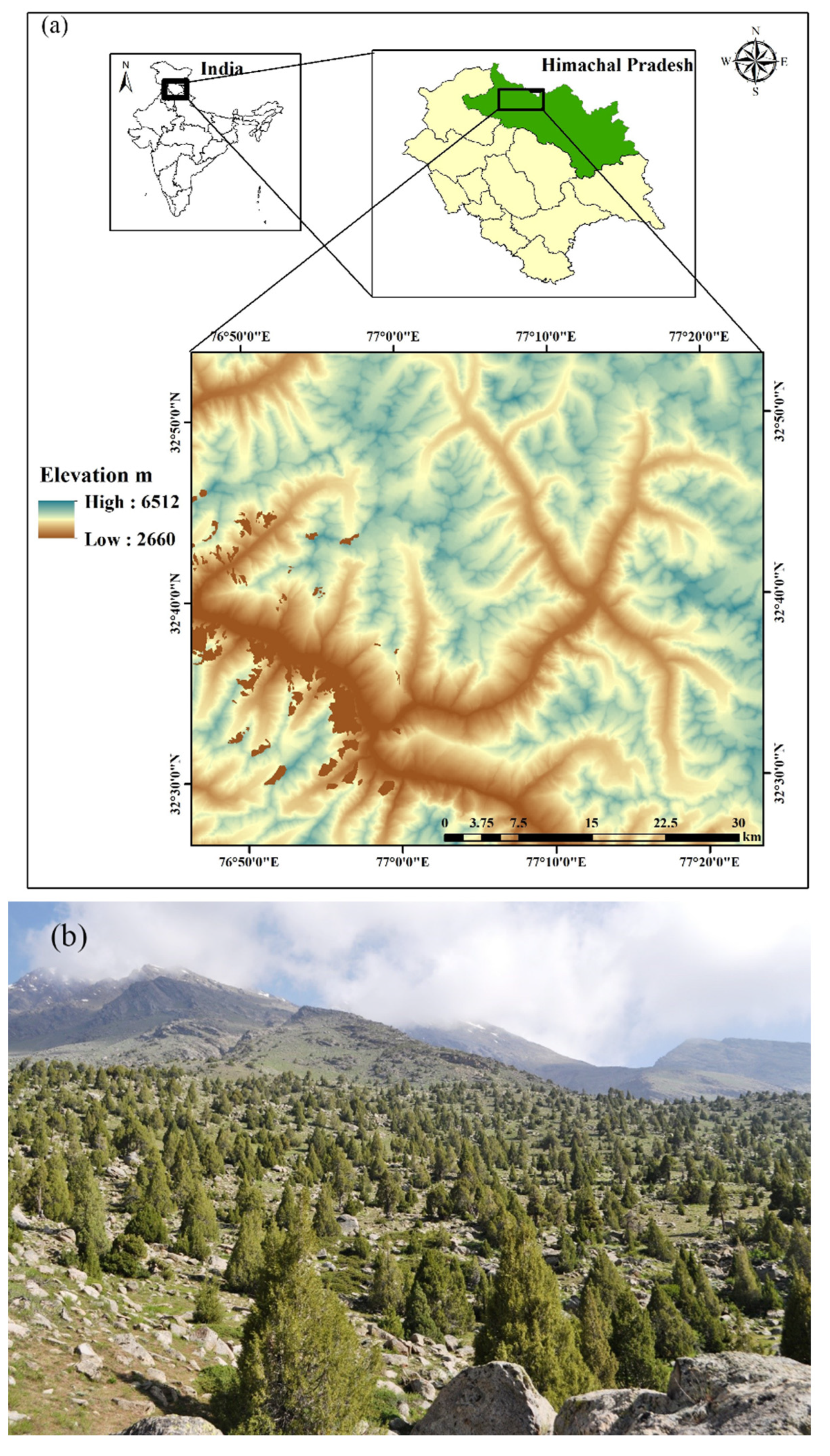
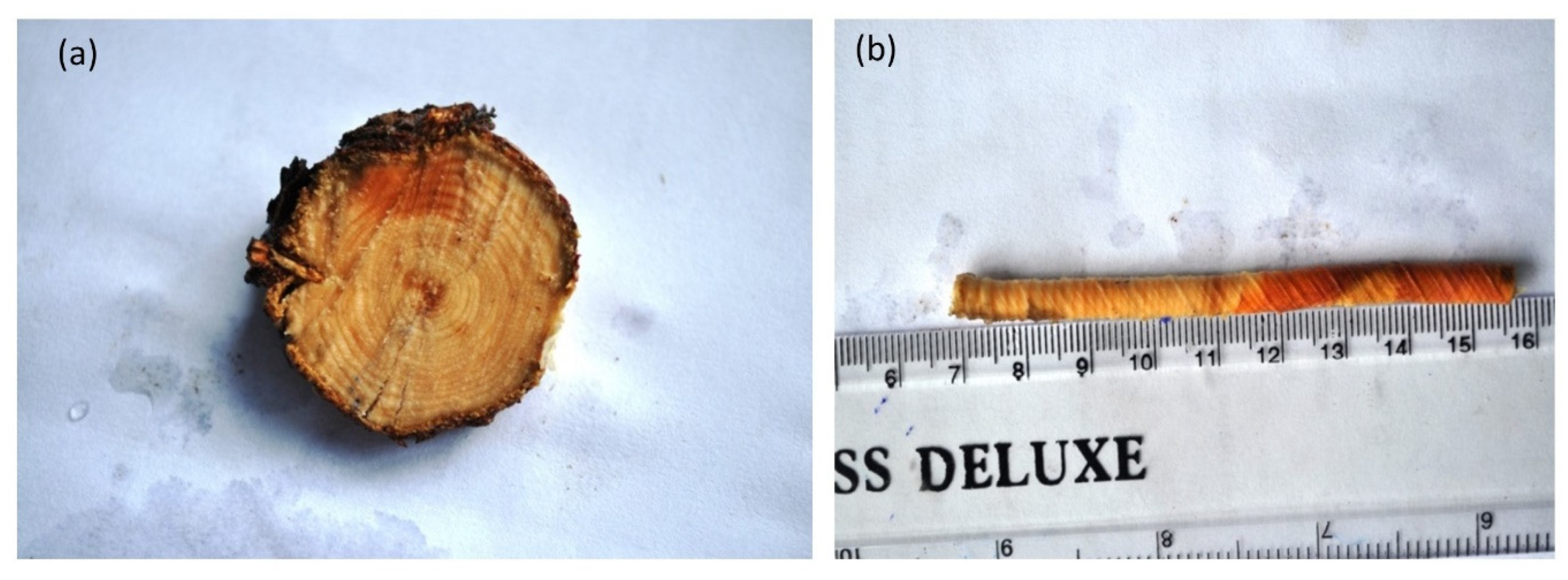



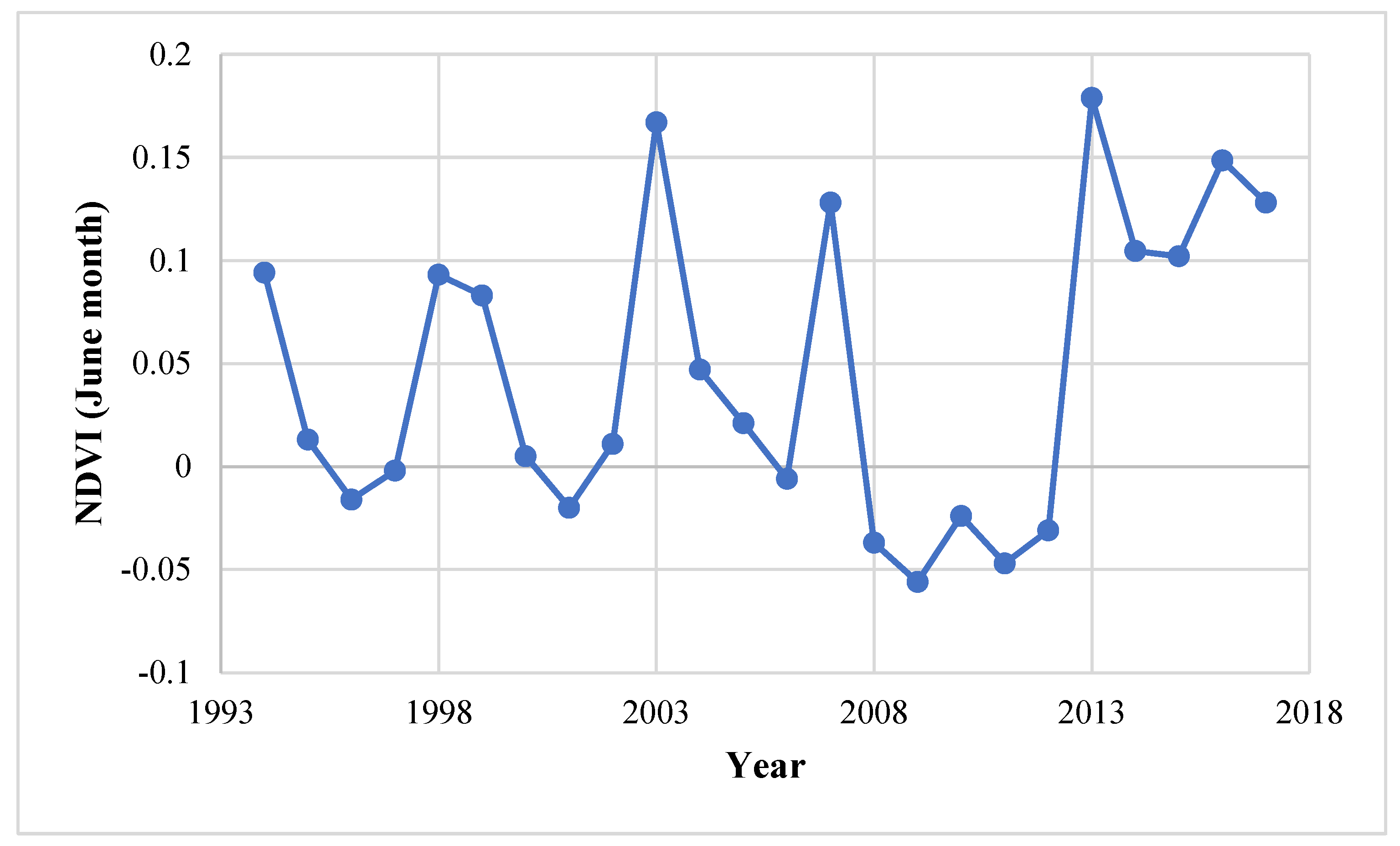
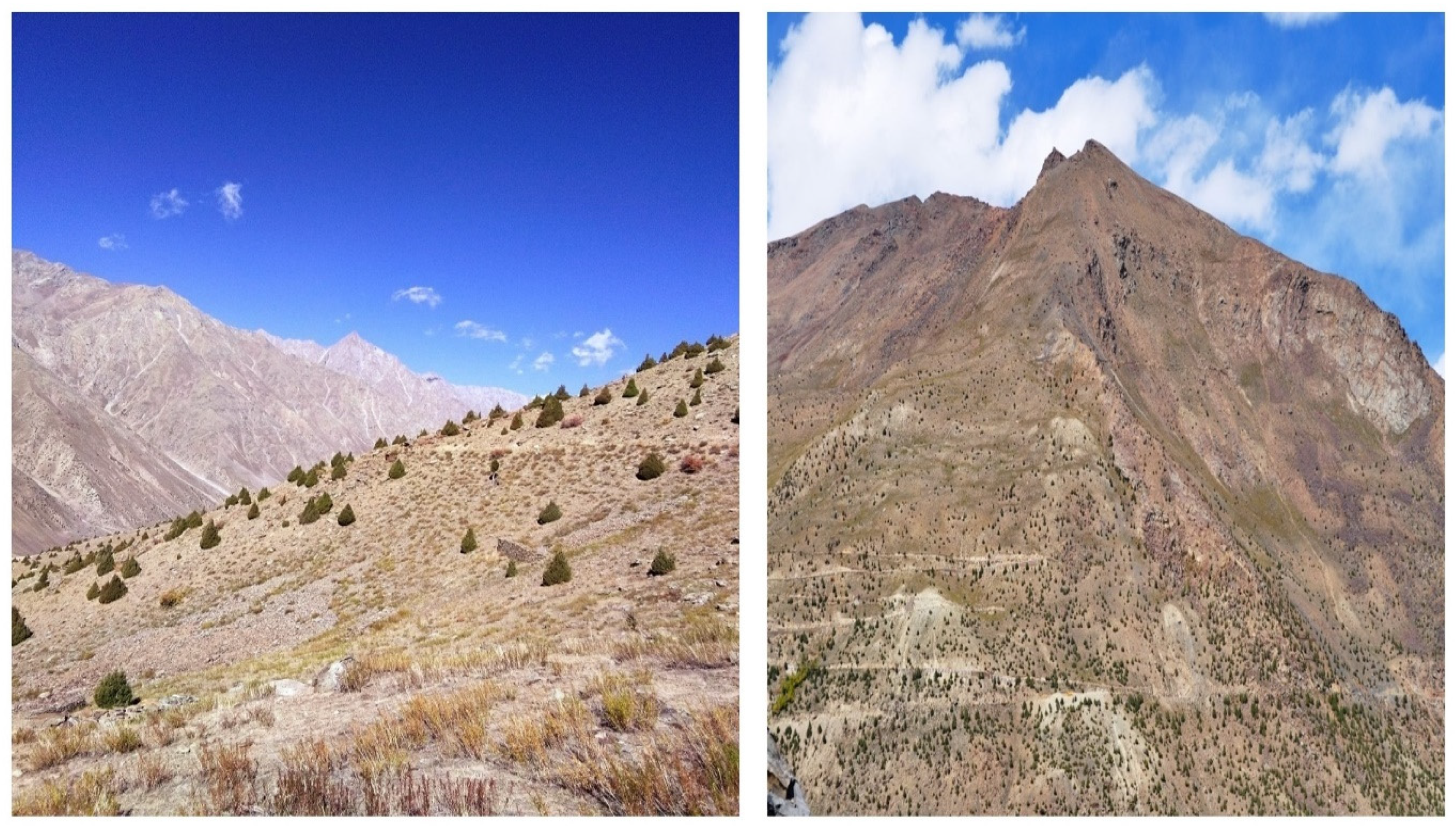
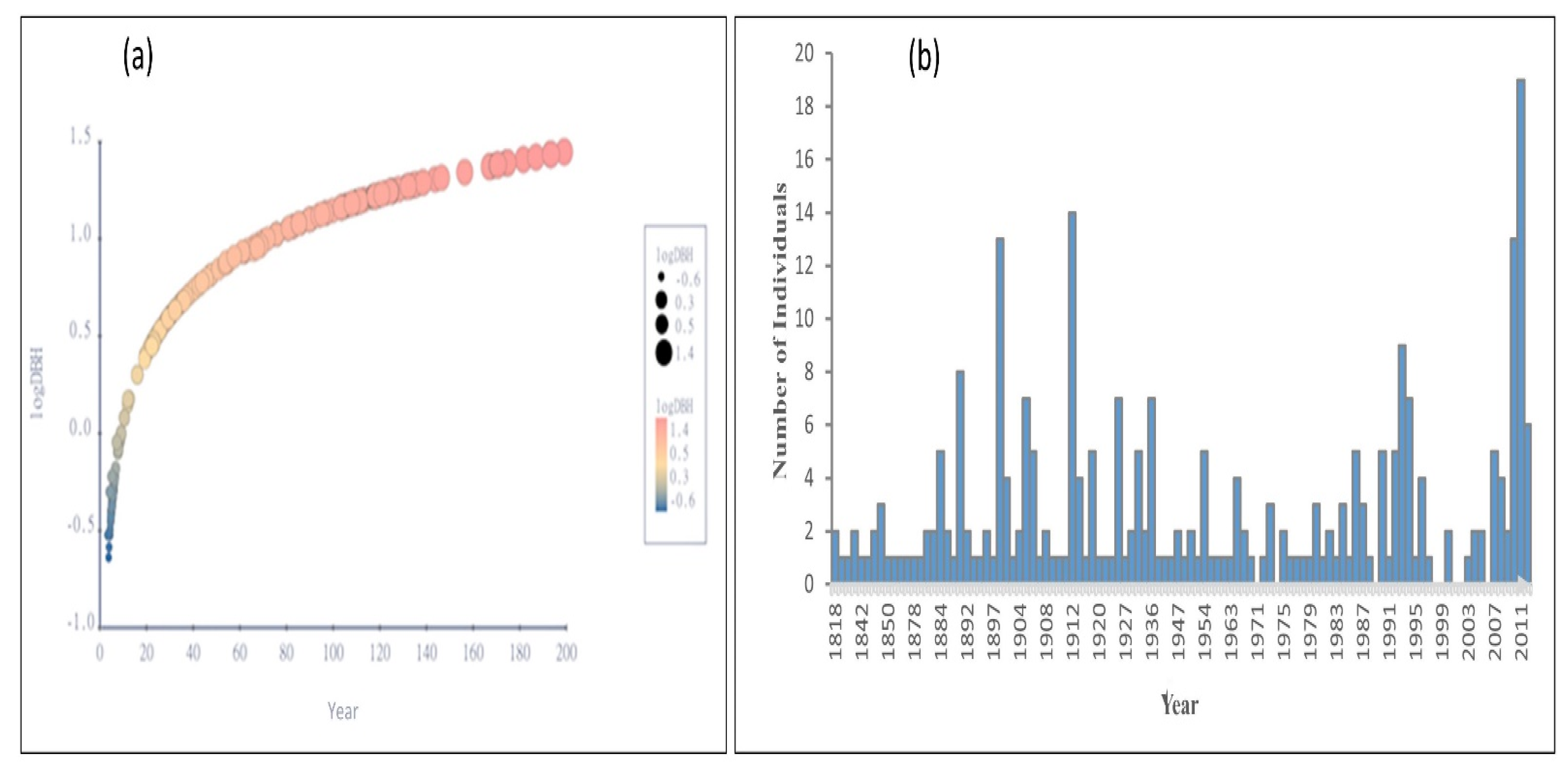
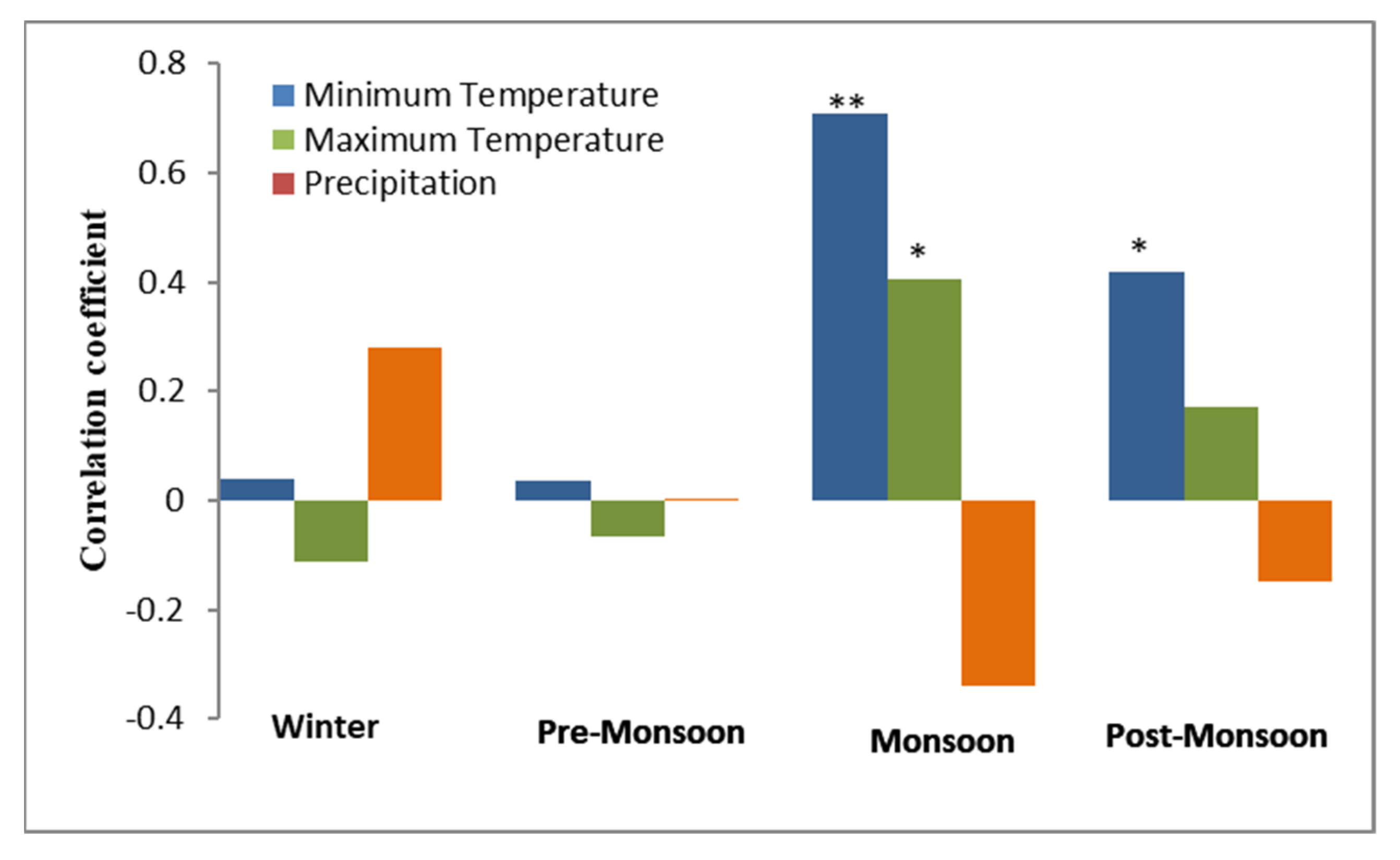
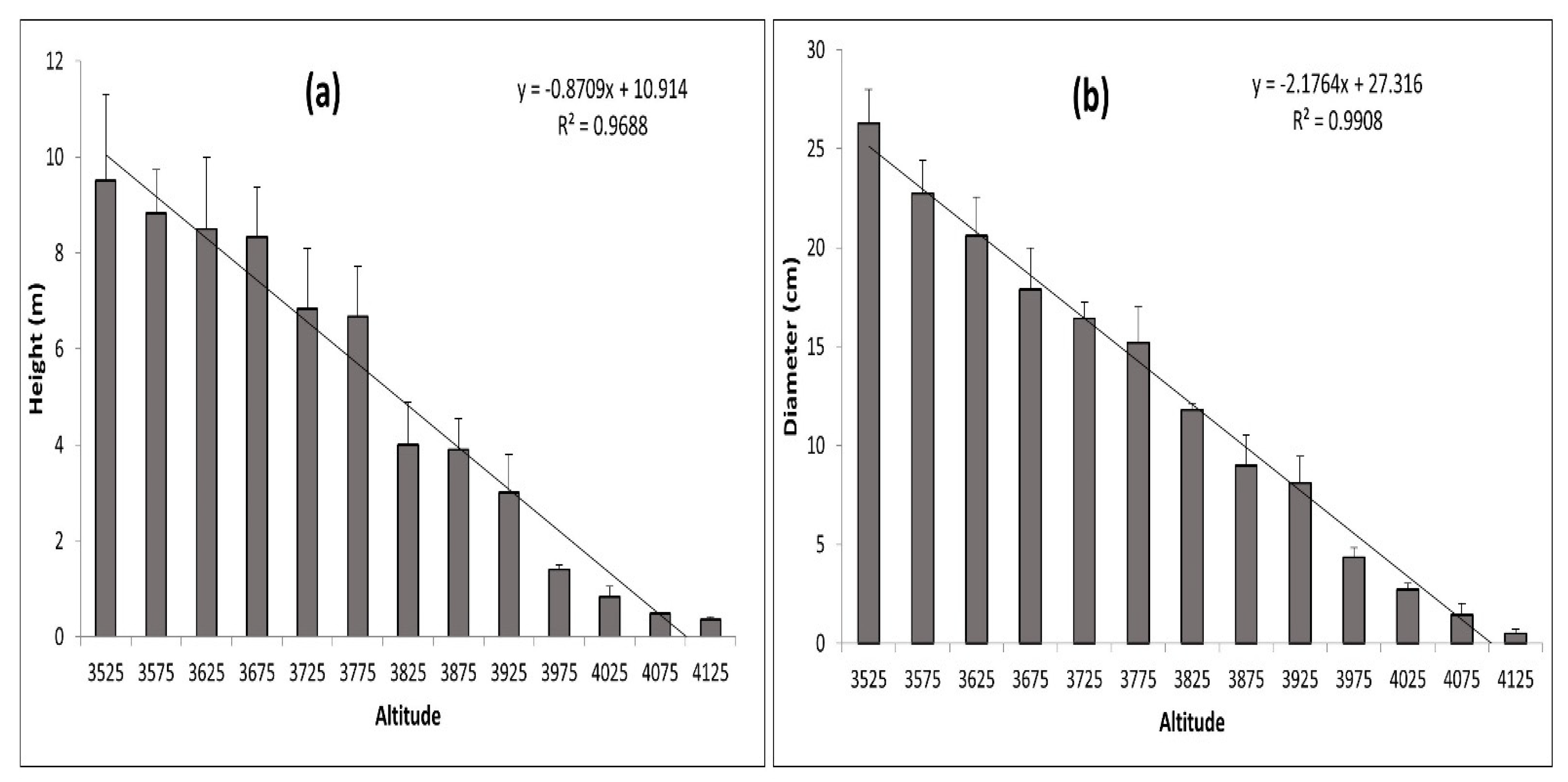
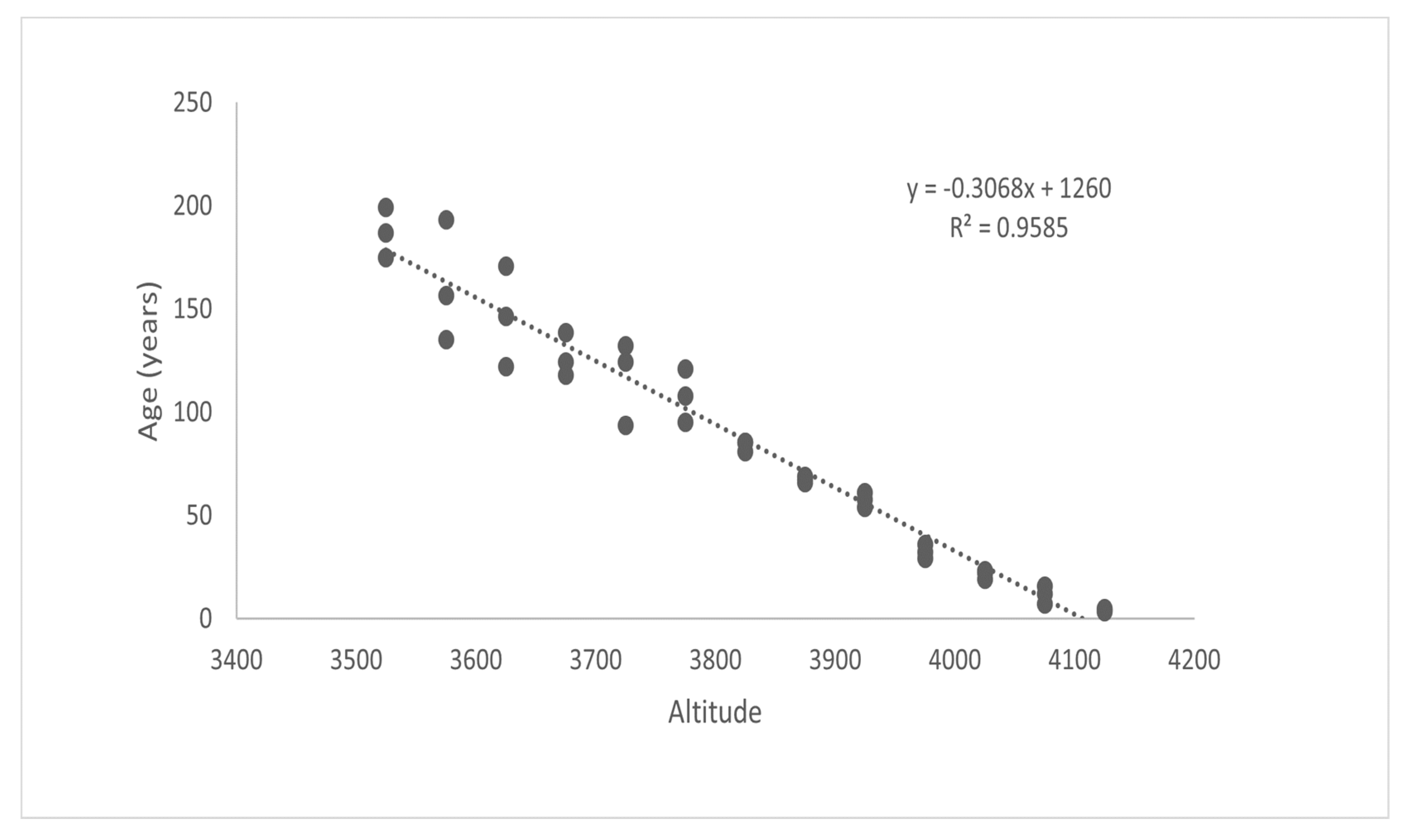

| NDVI Value | Area (ha) | Area Change (ha) | Change (%) | |
|---|---|---|---|---|
| Year 1994 | Year 2017 | |||
| <0 | 248,036.8 | 125,182.1 | −122,855 | −49.53 |
| 0–0.15 | 50,285.97 | 171,051.5 | 120,765.5 | 240.16 |
| 0.15–0.30 | 25,537.95 | 33,688.4 | 8150.45 | 31.91 |
| 0.30–0.50 | 7690.05 | 3363.3 | −4326.75 | −56.26 |
| >0.5 | 1473.75 | 84.6 | −1389.15 | −94.26 |
| Altitude | Number of Trees Sampled | Average Age | Range | Elevation Difference | Age Difference | Rate of Shift (Decade−1 in m) | Year−1 Shift (m) |
|---|---|---|---|---|---|---|---|
| 3525 m | 3 | 186.99 | 174–199 | 50 | 25.36 | 19.72 | 1.97 |
| 3575 m | 3 | 161.63 | 122–170 | 50 | 15.16 | 32.98 | 3.30 |
| 3625 m | 3 | 146.47 | 135–193 | 50 | 19.44 | 25.72 | 2.57 |
| 3675 m | 3 | 127.03 | 93–132 | 50 | 10.19 | 49.07 | 4.91 |
| 3725 m | 3 | 116.84 | 118–132 | 50 | 8.77 | 57.01 | 5.70 |
| 3775 m | 3 | 108.07 | 95–120 | 50 | 24.17 | 20.69 | 2.07 |
| 3825 m | 3 | 83.9 | 81–85 | 50 | 16.4 | 30.49 | 3.05 |
| 3875 m | 3 | 67.5 | 54–61 | 50 | 9.91 | 50.45 | 5.05 |
| 3925 m | 3 | 57.59 | 67–69 | 50 | 24.96 | 20.03 | 2.00 |
| 3975 m | 3 | 32.63 | 29–36 | 50 | 10.83 | 46.17 | 4.62 |
| 4025 m | 3 | 21.8 | 19–23 | 50 | 10.2 | 49.02 | 4.90 |
| 4075 m | 3 | 11.6 | 7–16 | 50 | 7.35 | 68.03 | 6.80 |
| 4125 m | 3 | 4.25 | 3–5 | - | - | - | - |
| Average | 50 | 15.23 | 39.11 | 3.91 | |||
Publisher’s Note: MDPI stays neutral with regard to jurisdictional claims in published maps and institutional affiliations. |
© 2022 by the authors. Licensee MDPI, Basel, Switzerland. This article is an open access article distributed under the terms and conditions of the Creative Commons Attribution (CC BY) license (https://creativecommons.org/licenses/by/4.0/).
Share and Cite
Kumar, D.; Bhardwaj, D.R.; Thakur, C.L.; Sharma, P.; Ayele, G.T. Vegetation Shift of Juniperus macropoda Boisser Forest in Response to Climate Change in North-Western Himalayas, India. Forests 2022, 13, 2088. https://doi.org/10.3390/f13122088
Kumar D, Bhardwaj DR, Thakur CL, Sharma P, Ayele GT. Vegetation Shift of Juniperus macropoda Boisser Forest in Response to Climate Change in North-Western Himalayas, India. Forests. 2022; 13(12):2088. https://doi.org/10.3390/f13122088
Chicago/Turabian StyleKumar, Dhirender, Daulat R. Bhardwaj, Chaman L. Thakur, Prashant Sharma, and Gebiaw T. Ayele. 2022. "Vegetation Shift of Juniperus macropoda Boisser Forest in Response to Climate Change in North-Western Himalayas, India" Forests 13, no. 12: 2088. https://doi.org/10.3390/f13122088








